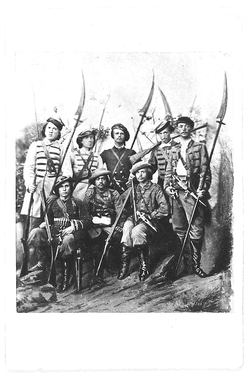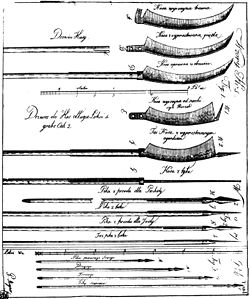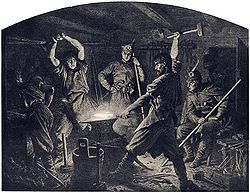
War scythe
Encyclopedia

Pole weapon
A pole weapon or polearm is a close combat weapon in which the main fighting part of the weapon is placed on the end of a long shaft, typically of wood, thereby extending the user's effective range. Spears, glaives, poleaxes, halberds, and bardiches are all varieties of polearms...
, similar to a fauchard
Fauchard
A fauchard is a type of polearm weapon, which was used in medieval Europe from the 11th through the 14th centuries. The design consisted of a curved blade put atop a 2 m long pole. The blade bore a moderate to strong curve along its length, however unlike a glaive the cutting edge was only on the...
, usually created from standard scythe
Scythe
A scythe is an agricultural hand tool for mowing grass, or reaping crops. It was largely replaced by horse-drawn and then tractor machinery, but is still used in some areas of Europe and Asia. The Grim Reaper is often depicted carrying or wielding a scythe...
s. The blade of the scythe is transformed so as to extend upright from the pole, thus forming an infantry weapon practical both in offensive actions against infantry and as a defensive measure against enemy cavalry
Cavalry
Cavalry or horsemen were soldiers or warriors who fought mounted on horseback. Cavalry were historically the third oldest and the most mobile of the combat arms...
.
History

Chaff cutter
Chaff cutter — a mechanical device for cutting straw or hay into small pieces — before being mixed together with other forage and fed to horses and cattle. This aids the animal's digestion and prevents animals from rejecting any part of their food....
was used.
War scythes were a popular weapon of choice and opportunity of many peasant uprisings
Peasant revolt
Peasant, Peasants' or Popular is variously paired with Revolt, Uprising and War and may refer to :*Daze Village Uprising 209 BC*Yellow Turban Rebellion 184...
throughout history. To name just a few examples, ancient Greek historian, Xenophon
Xenophon
Xenophon , son of Gryllus, of the deme Erchia of Athens, also known as Xenophon of Athens, was a Greek historian, soldier, mercenary, philosopher and a contemporary and admirer of Socrates...
, describes in his work (Anabasis
Anabasis (Xenophon)
Anabasis is the most famous work, in seven books, of the Greek professional soldier and writer Xenophon. The journey it narrates is his best known accomplishment and "one of the great adventures in human history," as Will Durant expressed the common assessment.- The account :Xenophon accompanied...
) the chariot
Chariot
The chariot is a type of horse carriage used in both peace and war as the chief vehicle of many ancient peoples. Ox carts, proto-chariots, were built by the Proto-Indo-Europeans and also built in Mesopotamia as early as 3000 BC. The original horse chariot was a fast, light, open, two wheeled...
s of Cyrus the Younger
Cyrus the Younger
Cyrus the Younger, son of Darius II of Persia and Parysatis, was a Persian prince and general. The time of his birth is unknown, but he died in 401 B.C. The history of Cyrus and of the retreat of the Greeks is told by Xenophon in his Anabasis. Another account, probably from Sophaenetus of...
which used scythes. Lithuanian and Polish peasants used war scythes during the 17th century Swedish invasion (The Deluge). In the 1685 battle of Sedgemoor
Battle of Sedgemoor
The Battle of Sedgemoor was fought on 6 July 1685 and took place at Westonzoyland near Bridgwater in Somerset, England.It was the final battle of the Monmouth Rebellion and followed a series of skirmishes around south west England between the forces of James Scott, 1st Duke of Monmouth and the...
, James Scott, 1st Duke of Monmouth
James Scott, 1st Duke of Monmouth
James Scott, 1st Duke of Monmouth, 1st Duke of Buccleuch, KG, PC , was an English nobleman. Originally called James Crofts or James Fitzroy, he was born in Rotterdam in the Netherlands, the eldest illegitimate son of Charles II and his mistress, Lucy Walter...
, fielded a 5000 strong peasant unit armed with war scythes. They were used in the 1784 Transylvanian peasants Revolt of Horea, Cloşca and Crişan
Revolt of Horea, Closca and Crisan
The Revolt of Horea, Cloșca and Crișan began in Zarand County, Transylvania, but it soon spread all throughout the Apuseni Mountains...
, in the war in the Vendée by royalist peasant troops, in the 1st War of Schleswig in 1848 in Denmark
Denmark
Denmark is a Scandinavian country in Northern Europe. The countries of Denmark and Greenland, as well as the Faroe Islands, constitute the Kingdom of Denmark . It is the southernmost of the Nordic countries, southwest of Sweden and south of Norway, and bordered to the south by Germany. Denmark...
, and again in various Polish - Lithuanian uprisings: Kościuszko Uprising
Kosciuszko Uprising
The Kościuszko Uprising was an uprising against Imperial Russia and the Kingdom of Prussia led by Tadeusz Kościuszko in Poland, Belarus and Lithuania in 1794...
in 1794, when in battle of Racławice scythemen successfully charged and captured Russian
Russia
Russia or , officially known as both Russia and the Russian Federation , is a country in northern Eurasia. It is a federal semi-presidential republic, comprising 83 federal subjects...
artillery
Artillery
Originally applied to any group of infantry primarily armed with projectile weapons, artillery has over time become limited in meaning to refer only to those engines of war that operate by projection of munitions far beyond the range of effect of personal weapons...
. In that year Chrystian Piotr Aigner
Chrystian Piotr Aigner
Chrystian Piotr Aigner was a Polish architect and theoretician of architecture.-Life:...
published a field manual
Field Manual
__FORCETOC__Field Manual is the second solo album by Death Cab for Cutie guitarist Chris Walla, released on January 29, 2008 on Barsuk Records. The album is Walla's first under his own name...
Short Treatise on Pikes and Scythes, detailing the training and operation of scythe-equipped forces, the first and probably the only such book in the history of warfare. War scythes were later used in the November Uprising
November Uprising
The November Uprising , Polish–Russian War 1830–31 also known as the Cadet Revolution, was an armed rebellion in the heartland of partitioned Poland against the Russian Empire. The uprising began on 29 November 1830 in Warsaw when the young Polish officers from the local Army of the Congress...
in 1831, January Uprising
January Uprising
The January Uprising was an uprising in the former Polish-Lithuanian Commonwealth against the Russian Empire...
in 1863 and Silesian Uprising in 1921. The name was used even in 1939, but the unit Scythemen of Gdynia
Gdynia
Gdynia is a city in the Pomeranian Voivodeship of Poland and an important seaport of Gdańsk Bay on the south coast of the Baltic Sea.Located in Kashubia in Eastern Pomerania, Gdynia is part of a conurbation with the spa town of Sopot, the city of Gdańsk and suburban communities, which together...
was armed rather with hunting guns.
Specifics

Pole weapon
A pole weapon or polearm is a close combat weapon in which the main fighting part of the weapon is placed on the end of a long shaft, typically of wood, thereby extending the user's effective range. Spears, glaives, poleaxes, halberds, and bardiches are all varieties of polearms...
, the war scythe is characterised by long range and powerful force (due to lever
Lever
In physics, a lever is a rigid object that is used with an appropriate fulcrum or pivot point to either multiply the mechanical force that can be applied to another object or resistance force , or multiply the distance and speed at which the opposite end of the rigid object travels.This leverage...
age): there are documented examples where a scythe has cut through a metal helmet. They could be used, depending on construction and tactics, to make slashing or stabbing attacks, and due to their uncommon looks and significant power, could have a psychological impact on an unprepared enemy. However, as most pole weapons, their disadvantages were their weight (which could quickly tire the user) and slow speed. The war scythe was probably an early ancestor of more professional pole weapons like halberd
Halberd
A halberd is a two-handed pole weapon that came to prominent use during the 14th and 15th centuries. Possibly the word halberd comes from the German words Halm , and Barte - in modern-day German, the weapon is called Hellebarde. The halberd consists of an axe blade topped with a spike mounted on...
s.
See also

- FauchardFauchardA fauchard is a type of polearm weapon, which was used in medieval Europe from the 11th through the 14th centuries. The design consisted of a curved blade put atop a 2 m long pole. The blade bore a moderate to strong curve along its length, however unlike a glaive the cutting edge was only on the...
- KamaKama (weapon)The is a traditional Filipino and Japanese farming implement similar to a small scythe used for reaping crops and also employed as a weapon...
– Japanese hand scythe - FalxFalxFalx is a Latin word originally meaning sickle, but was later used to mean any of a number of tools that had a curved blade that was sharp on the inside edge such as a scythe...
– A sword with a inward curved blade - RhomphaiaRhomphaiaThe Rhomphaia was a close combat bladed weapon used by the Thracians as early as 400 BC. Most rhomphaias were polearms, featuring a straight or slightly curved single-edged blade attached to a pole that was considerably shorter than the blade. Some rhomphaias had short handles that extended to...
– larger variant of the falx, much similar to the war scythe

